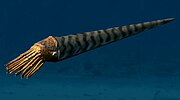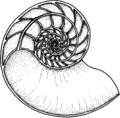Nautiloids are a group of marine cephalopods (Mollusca) which originated in the Late Cambrian and are represented today by the living Nautilus and Allonautilus...
37 KB (3,465 words) - 01:30, 15 November 2024
is the long, cone-shaped shell belonging to several species of ancient nautiloid cephalopod—the prehistoric ancestors of today's marine cephalopod mollusks...
4 KB (414 words) - 10:21, 22 April 2024
Orthoceras is a genus of extinct nautiloid cephalopod restricted to Middle Ordovician-aged marine limestones of the Baltic States and Sweden. This genus...
5 KB (437 words) - 01:31, 30 October 2024
chambers enclosed between two adjacent septa in the phragmocone of a nautiloid or ammonoid cephalopod molluscus. These can be seen in cross-sections...
1 KB (131 words) - 04:55, 21 May 2024
coleoids (i.e., octopuses, squid and cuttlefish) than they are to shelled nautiloids (such as the living Nautilus). The earliest ammonoids appeared during...
52 KB (5,802 words) - 23:24, 29 October 2024
Cambrian-Ordovician extinction event, the niches of large carnivores were taken over by nautiloid cephalopods such as Cameroceras and later eurypterids such as Jaekelopterus...
20 KB (2,004 words) - 20:09, 3 November 2024
Multiceratoidea is a major subclass or superorder of Paleozoic nautiloid cephalopods. Members of this group can be characterized by nautilosiphonate connecting...
6 KB (564 words) - 12:40, 14 October 2024
Endocerida is an extinct nautiloid order, a group of cephalopods from the Lower Paleozoic with cone-like deposits in their siphuncle. Endocerida was a...
13 KB (1,355 words) - 12:35, 14 October 2024
Lituites (category Nautiloids)
Lituites is an extinct nautiloid genus from the Middle Ordovician and type for the Lituitidae (a tarphycerid family) that in some more recent taxonomies...
2 KB (199 words) - 03:41, 12 December 2022
the internal chambers (camerae) of the shell of a cephalopod, namely nautiloids or ammonoids. As the creature grows, its body moves forward in the shell...
3 KB (373 words) - 10:36, 23 June 2024
became dominant during the Ordovician period, represented by primitive nautiloids. The class now contains two, only distantly related, extant subclasses:...
139 KB (15,486 words) - 14:22, 6 November 2024
be the upper surface. All cephalopods with external shells except the nautiloids became extinct by the end of the Cretaceous period 65 million years ago...
98 KB (9,825 words) - 00:31, 19 November 2024
Allonautilus (category Nautiloid genera)
Ward, P.D. & W.B. Saunders 1997. Allonautilus: a new genus of living nautiloid cephalopod and its bearing on phylogeny of the Nautilida. Journal of Paleontology...
3 KB (181 words) - 01:04, 28 April 2024
With only a handful of species surviving today, the Nautiloids flourished during the early Paleozoic era, from the Late Cambrian, where they constituted...
85 KB (4,733 words) - 00:20, 3 November 2024
the body whorl. It is the outermost or last chamber in the shell of a nautiloid or ammonoid. The body of the animal occupies the living chamber, apart...
3 KB (355 words) - 04:58, 19 March 2024
trilobites and the nautiloid cephalopod including the orthocerid order of extinct Silurian-Devonian orthoceratoid cephalopods. Nautiloid cephalopods are...
21 KB (2,715 words) - 15:43, 4 August 2024
Cameroceras (category Prehistoric nautiloid genera)
scientific papers previously treated Cameroceras as the absolute largest nautiloid-grade cephalopod, with a shell length reaching 5.7 metres (19 ft) or even...
21 KB (1,574 words) - 22:15, 18 September 2024
the shell of a cephalopod. It is divided by septa into camerae. In most nautiloids and ammonoids, the phragmocone is a long, straight, curved, or coiled...
2 KB (254 words) - 16:50, 14 August 2024
This list of nautiloids is a comprehensive listing of all genera that have ever been included in the subclass Nautiloidea, excluding purely vernacular...
39 KB (1,168 words) - 21:27, 30 April 2024
Riocerida (category Prehistoric nautiloids)
Riocerida, originally named as Rioceratida, is an extinct order of Ordovician nautiloid cephalopods. They were the earliest-diverging members of the major group...
3 KB (223 words) - 12:43, 14 October 2024
Science. Retrieved June 9, 2021. John, James St (2007-07-31). Fossil nautiloid shell with original iridescent nacre in fossiliferous asphaltic limestone...
36 KB (3,894 words) - 06:46, 11 August 2024
descending from bactritoid nautiloids. Ammonoids during this time period were simple and differed little from their nautiloid counterparts. These ammonoids...
69 KB (7,582 words) - 18:25, 11 November 2024
Spiriferida, etc.) recover and become very common again, but trilobites and nautiloids decline. Glaciation in East Gondwana continues from Late Devonian. Tuhua...
174 KB (9,743 words) - 01:50, 14 November 2024
Coleoidea, diverged from the nautiloids long ago and the nautilus has remained relatively unchanged since. Nautiloids were much more extensive and varied...
54 KB (5,486 words) - 13:08, 8 November 2024
also numerous, including the genera Murchisonia, Euomphalus, Naticopsis. Nautiloid cephalopods are represented by tightly coiled nautilids, with straight-shelled...
115 KB (12,087 words) - 20:00, 19 November 2024
Shell-Shock: Three University Of Arkansas Students Find World's Longest Nautiloid Fossil - an article about the Arkansas Rayonnoceras found in 2003....
3 KB (310 words) - 15:53, 15 March 2024
as an adult. This same type of cross section is found in much earlier nautiloids such as Bassleroceras and Clitendoceras from the Ordovician period, which...
17 KB (1,618 words) - 22:08, 7 April 2024
along the ventral edge of the shell. In some fossil straight shelled nautiloids, cylindrical calcareous growths ("siphuncular deposits") around the siphuncle...
8 KB (878 words) - 12:43, 14 October 2024
geodized pentamerid brachiopods from strata in Indiana Sphooceras was a Nautiloid cephalopod found in Silurian strata of the Czech Republic Jamoytius was...
59 KB (5,834 words) - 02:26, 14 November 2024
Plectronoceratoidea (category Nautiloids)
Plectronoceratoidea is a superorder or subclass containing primitive nautiloids from the Late Cambrian and Early Ordovician. This group is best considered...
5 KB (473 words) - 12:42, 14 October 2024





















